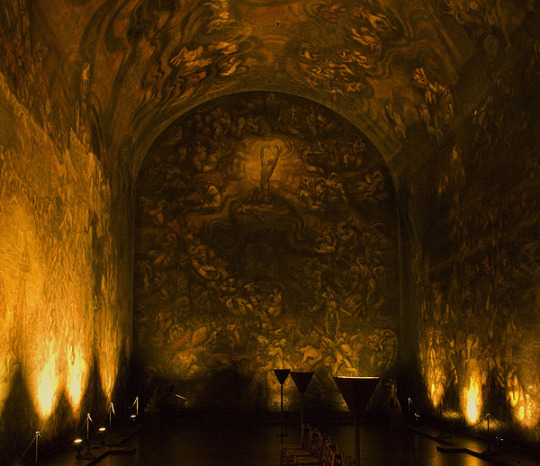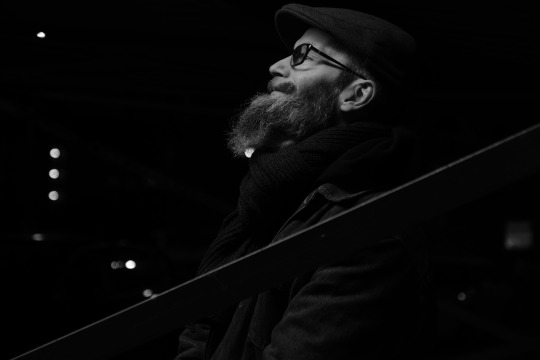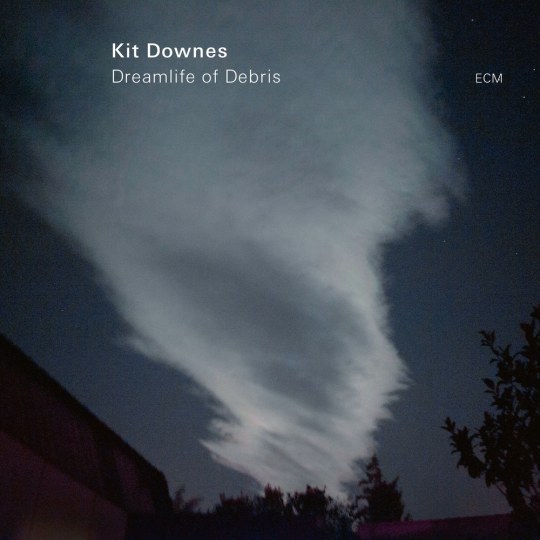#stian westerhus solo
Explore tagged Tumblr posts
Text
194: Stian Westerhus // The Matriarch and the Wrong Kind of Flowers

The Matriarch and the Wrong Kind of Flowers Stian Westerhus 2012, Rune Grammofon
In 1926, the Norwegian artist Emanuel Vigeland began construction on a building in Oslo intended to serve as a future museum for his paintings and sculptures. By the 1940s, he’d decided it would also serve as his mausoleum, and had the windows of its main hall bricked in. The hall, where his ashes now reside in an ornate urn above the entrance door, is covered in vast frescoes depicting the forces of life and death. Illumination in the mausoleum is held to the dimness of candlelight, allowing details of the frescoes to gradually reveal themselves as the eye acclimates to the darkness: legions of couples copulating in every imaginable array; a squalling newborn cradled in the bony palms of Death; a skeletal pair in mid-coitus, who produce a column of smoke in which infant children can be seen floating. One drawing bears a small note from the artist: “When you see a naked human body and are vexed at what you see, then reproach God for what He has created, if you dare."

Vigeland's urn and fresco detail.
youtube
I mention all this not only because I have an intense desire to talk about sexy skeletons, but because a small note on the back cover of guitarist Stian Westerhus’s The Matriarch and the Wrong Kind of Flowers indicates that portions of the album were recorded in the mausoleum. Westerhus has collaborated extensively with artists like Sidsel Endresen, Ulver, and Jaga Jazzist, but this is a truly solo work: austere, darkly-hued electroacoustic music that at times is nearly unrecognizable as originating from a guitar thanks to the artist’s legions of pedals and punishing digital processing. Westerhus would’ve sought the mausoleum not only for its sympathetic mood, but also its unique acoustics: according to the museum’s caretakers, the sound of a single footstep in the stone hall will echo for 14 seconds.
When I saw Westerhus in a small room nearly ten years ago, I recall his set being intense, loud to the lip of discomfort, and that he would’ve been visually well-cast as a darkwave boatman Charon. On this immaculately mixed and recorded LP, it’s easier to detect the nuances of his haunting compositions, which can hint at modern chamber music (as on “Guiding the Pain,” which has something of the flavour of Górecki to me), or flit between harsh noise and clean guitar. Making this kind of blackwork ambient music rise above the pleasures of a defective refrigerator motor requires a rare combination of discipline and instinct; like a lurking spider, Westerhus knows when to keep still, and when to move.

194/365
#stian westerhus#halloweek#emanuel vigeland#'10s music#rune grammofon#experimental music#electroacoustic#norwegian music#experimental jazz
4 notes
·
View notes
Text

Lee Riley "From Here We Are Nowhere".
pic: Nicola Onions
On 28th July we release drone/ ambient/ doom artist Lee Riley album "From Here We Are Nowhere". Oxford based experimental composer Lee Riley goes right back to the origins of Eyeless Records and this is a joint venture with his own imprint Iller Eye. It will be released digitally and on stream as well as a ltd lancing pack CD and contains some of the most immersive drone music this year. I caught up with Lee to ask about his process to complement the album...
Oxford
What’s the scene like in Oxford at the moment? When I was there it was incredibly collaborative and supportive and it’s where Eyeless was born…are you part of a strong community there or are you more independent as an artist?
Lots of great music as always in Oxford, the promoters at Divine Schism are bringing exciting bands to town regularly. I have a variable taste and like lots of types of music. A few favourites and highly recommended, on the heavier side bands like Ghosts In The Photographs, The Hope Burden, Sinews are doing well with recently released material or playing regularly. The experimental side there are things happening, I feel more independent but have many friends in other bands who support other.
I don't play solo live much. But would love to play more. I have had a close connection to Oxford over the years both in music and the arts.
It was great being involved in the early incarnation of Eyeless and working other promoters who have left Oxford. Since 2007 I have carried on both musically and visually. Studying sonic art and forming collaborative projects with other musicians, dancers and artists. I have curated sound art exhibitions and occasionally events too.
Influence
Who informs your practice? There’s a remarkably rich sound to your pallet feels like there’s a lot going on in there…scraping, drones, dissonance percussion vocals x
I wanted to play a bit more on these recordings, still working with layers of drones and noise. But having more textures. No vocals but the guitar can be manipulated in a way it sounds like a voice.
I wanted to mix acoustic and electric guitar on this album, I still need to try it live at some point.
I have many influences sometimes films and TV shows like Dark. I admire musicians like Stian Westerhus, Tim Hecker, Sunn O))). I have always tried to do my own thing and find new ways to enhance what I create.
Method
Is there a lot of layering or is it more live? To what extent does improvisation inspire your process? Or is it very tightly controlled?
The album is very succinct was it difficult to keep the tracks quite economical considering the genre you were working in?
As mentioned above I wanted to play more being able to control the sounds more instead relying heavily on delays and layers. I wanted to separate the sounds to allow space and depth to the recordings.
It feels like in your work you are exploring the possibilities of prepared guitar and extended techniques of playing guitar….
I have always treated the guitar as a sound tool and not and instrument. Such as using the body of the acoustic guitar or bowing and scraping the strings, etc.
I have worked with Mike Bannard in the Studio for a few releases, he understands my approach and what I want to produce and he suggests different mixing/recording techniques. He works with lots of bands and has a relaxed environment at Safehouse Studio and he is always up for exploring new ways of recording. This is my 3rd release with him on board. He has really helped bring out the details of my sounds and we collaborate in a group called UNMAN.
Influence
The final track “No one knows what’s inside “ offers a climactic ending of noise and crescendo…is tension and release a big part of your compositional method?
My approach has always had a loose improvised feel but I feel that the composition elements evolve from playing and having creative freedom helps. I know how to make certain sounds but it's how I use them. It's ike a blank canvas layers of sounds replacing the paint. They sound similar yet different each time or when put together.
This session was made into these pieces, revisiting them like sketches. Some sounds repeat on different tracks, this helped me arrange the sequence of the tracks as a whole but they also work as individual pieces of music.
As mentioned above films and TV shows often have great sound design and atmosphere. I have always tried this whilst making my music, probably sounds cheesy but taking the listener or audience on a journey.
Are there any albums you are excited by atm would you like to talk about these?
I really like the recent album by Wolf Eyes album.
I can't wait to see Big Brave again in September, there albums sound so good and have lots of depth to there sound. Stian Westerhus has some new recordings coming soon, look forward to those.
Also I highly recommend you listen to the Recent Ghosts In The Photographs album, I had the privilege of guesting on one of the tracks. Really great underated band from Oxfordshire.
Future Plans
What’s next for you as an artist?
I hope to play solo live more both in Oxford and different places. It's been challenging for everyone making music or bands playing over the past few years, it still is. I like performing so we will see what happens. I have a new project called DHELTR∆ with Beth Shearsby and Jeremy Moors. We have played a couple of live shows and hope to record soon.
I also hope to work with UNMAN a ongoing noise group featuring myself, Mike Bannard, John Grieve and we have a new drummer John Jobbagy. We played with Sly & The Family Drone recently which was good fun!
2 notes
·
View notes
Text










My albums selection for the next week:
Curse All Kings – Negation
Melophobia & Occupied Head - Zeitharmonien
Maja S. K. Ratkje & Stian Westerhus - All looses are restored
Nicolas Dick, Claude Favre – Autopsies
Jonas Kocher - Solo
Fredi Lüscher, Urs Voerkel – Weiss
Philippe-Marcel Iung – Subit Methane
Pauline Oliveros – Primordial - Lift
Règne du Vide - Misère ou servitude
Rhys Chatham & Z'EV - s/t
#musical selection#curse all kings#melophobia#occupied head#maja ratkje#stian westerhus#nicolas dick#claude favre#jonas kocher#fredi luscher#urs voerkel#philippe marcel lung#pauline oliveros#regne du vide#rhys chatham#z'ev#experimental music#neo classical#piano#avant garde#dark ambient#industrial music#ambiant music
1 note
·
View note
Audio
Hold On by Stian Westerhus from the benefit compilation Slava Ukraini!
#music#norwegian music#stian westerhus#stian westerhus solo#helge sten#deathprod#house of mythology#hom#russo ukrainian war
22 notes
·
View notes
Text
Kit Downes: Dreamlife of Debris (ECM, 2019)

Kit Downes: piano, organ; Tom Challenger: tenor saxophone; Lucy Railton: cello; Stian Westerhus: guitar; Sebastian Rochford: drums.
When keyboardist Kit Downes released Obsidian last year on ECM, it was a stunning album. He investigated three separate pipe organs of various sizes and the acoustic properties of each church, and the compositions yielded some provocative and stimulating music. With Dreamlife Of Debris the follow up to last year's effort, Downes utilizes not only the pipe organ once again from St. John's the Baptist in Snape but also piano, his main instrument. The music is an expansion of that found on Obsidian by Downes surrounding the keyboards with Tom Challenger on tenor saxophone (playing a larger role than the former album) cellist Lucy Railton, guitarist Stian Westerhus, and ECM regular, drummer Sebastian Rochford.
The album title is a reference to director Grant Gee's documentary Patience, about the writer W.G. Sebald's inspiration towards his seminal Rings of Saturn. For Downes, Dreamlife of Debris is a way of bringing life, a certain spirit to an inanimate object like an organ. Through looking at even a surface as a table, one can learn there is life and movement in what seems like a solid object-- the concept of giving life to seemingly everything is also a belief in Japanese Shinto-- and indeed in these eight tracks, the organ does come alive in a series of dreamlike sound scapes, where the notion of improvisation (and there is plenty) takes a secondary role to the overall textural environment in the music.
“Sculptor” begins with Challenger's breathy whispered tones. Alongside spidery melodic lines from Downes' piano. Aside from the striking use of space, Downes and Challenger engage in a delicate pas de deux, with strains of organ finally fading into the background at the close of the piece. The familiar fat, calliope sonority of the St John's the Baptist organ is at the forefront of “Circinus”. A Philip Glass like arpeggio sets the mood, Lucy Railton's legato cello, and harmonics adds a new color to the fray with Challenger gliding on top. The listener is transported to a cerulean sky, with a beautiful cloudy mist. The track could almost frame sections of the short Cloud from 1987's classic Japanese animated anthology Robot Carnival. “Pinwheel” captures the joy of a childlike innocence of a literal, bright metallic pinwheel blowing in the wind. As the piece progresses with Railton's cello, Downes' piano and wispy brushes and cymbal work from Rochford there is an underlying sadness and a cinematic quality of beautiful full color fading to black and white. “Bodes” is the album centerpiece, with a reflective melody bolstered by Challenger with soft, flute stop like organ in the background and Westerhus' mandolin like guitar trilling. The piece moves into a tense, nightmarish free improvisation carefully crafted by Downes in post production to match the overall sound of the church acoustics. Amorphous tones from synth pad like guitar beds, screeching cello harmonics and saxophone swirl around in an aural equivalent of a strong wind shuffling curtains creating horrifying, uncertain shapes in a dark room. “M7” was originally sung by Downes' wife, Ruth Goller, and is treated as a solo organ piece. The trailing decay of the whistle stop that Downes solos with that dips in pitch is strangely reminiscent of one of Lyle Mays' trademark patches found on tunes such as “Are You Going With Me?” and adds an intriguing sonic element. The closing “Blackeye” is almost a clash of the ancient and modern as Sebastian Rochford's strong tom tom groove brings it into the realm of the present juxtaposed with the ancient sound of Downes' organ.
Sound
Dreamlife of Debris is excellently captured by engineer Alex Bonney, who also recorded Obsidian. As with the previous album, it is produced by Sun Chung who, while firmly sticking to the ECM ethos of spacious, clear sound, tends to hone in on a quite atmospheric, eerie quality that has informed albums such as Near East Quartet by Songjae Son, Amorphae by Ben Monder and Lebroba by Andrew Cyrille. The sound stage is quite large with aerated piano, massive organ with the forceful sound of air moving through pipes, ghost like guitar, present cello, and saxophone. The album is most certainly reference quality and will thrill audiophiles. The album is especially effective on headphones, and the slight distance from the listener is a perfect match for headphones like the Beyerdynamic DT770 Pro's.
Closing Thoughts
Kit Downes has once more created a winning album expanding on the processes that began with Obsidian. The pipe organ is a incredible vessel for composition as a forefather of the modern synthesizer. Through a unique blend of organ, piano, tenor saxophone, cello, guitar and drums it is a journey through the unconscious where one is confronted with everything. The chamber aspect of most of the compositions does blur the line between the written and improvised and is performed in such a way that it is unclear where one line ends and the next begins. Through this masterful use of blurred lines the listener to focus on the arresting array of tones and textures used to convey the message.
Music rating: 10/10
Sound rating: 10/10
youtube
2 notes
·
View notes
Text
Bill Frisell - Music IS (2018)

"The tradition of solo jazz guitar recordings is a long one, with guitarists like Johnny Smith, Al Viola, George Van Eps, Lenny Breau and Joe Pass demonstrating just how far a mere six (in some cases, seven) strings could be taken on their own as far back as the 1950s. Subsequent guitar soloists like John Abercrombie and Ralph Towner went even further by, at times, taking advantage of the recording studio's facility to overdub layers of guitar to create even broader expanses. But it's been during the past two decades or so that guitarists like Eivind Aarset and Stian Westerhus have explored extensive use of looping and other technological innovations, truly developing the orchestral potential of their instrument. ... If ever there was an album title to reflect the infinite potential of an art form that has occupied most of [Bill] Frisell's life, it's Music IS. ..."
All About Jazz
Release: Bill Frisell "Music IS"
amazon
YouTube: Rambler (Alternate Version) (Live)
YouTube: Music IS @Full Album 2018 11 videos
0 notes
Text
Katta er endelig ute av sekken og svensk-trondhjemmeren Tomas Järmyr er offisielt presentert som den nye trommeslageren i verdens beste band – Motorpsycho. Tomas er ikke bare en trommeslager i verdensklasse, han er også helt umulig å plassere i en bås. Han har føttene godt planta i alle sjangre – og behersker alt fra de vareste lydlandskaper på solo cymbaler til hardcore pønk og lydinfernoet han leverer sammen med Zu. Her er noen konstellasjoner jeg har opplevd ham i de siste par-tre årene.
#gallery-0-4 { margin: auto; } #gallery-0-4 .gallery-item { float: left; margin-top: 10px; text-align: center; width: 100%; } #gallery-0-4 img { border: 2px solid #cfcfcf; } #gallery-0-4 .gallery-caption { margin-left: 0; } /* see gallery_shortcode() in wp-includes/media.php */
Med Sunswitch – Kristoffer Lo og Trond Frønes
Med Eldbjørg Raknes
Med Stian Westerhus og Mats Gustafsson
Med Kristoffer Lo og Michael Duch
Med Marita Røstad trio – Bjørn Marius Hegge
Solo cymbaler
Med Zu
Med Zu
Med Arne Torvik, Dan Peter Sundland, Espen Jørgensen Bjarnar, Kristoffer Eikrem, Martin Myhre Olsen
Med James Welburn
Med Doffs Poi – Mia Marlen Berg og Oscar Grönberg
Med The MaXx – Petter Kraft og Oscar Grönberg
Med Yodok III – Kristoffer Lo og Dirk Serries
Med Tor Haugerud
2017-01-02 Tomas Järmyr Katta er endelig ute av sekken og svensk-trondhjemmeren Tomas Järmyr er offisielt presentert som den nye trommeslageren i verdens beste band - Motorpsycho.
0 notes
Audio
All Your Wolves by Stian Westerhus from the album Redundance
#somethingneweveryday#music#norwegian music#stian westerhus#deathprod#hom#helge sten#house of mythology#nothing new really#stian westerhaus#stian westerhus solo
8 notes
·
View notes